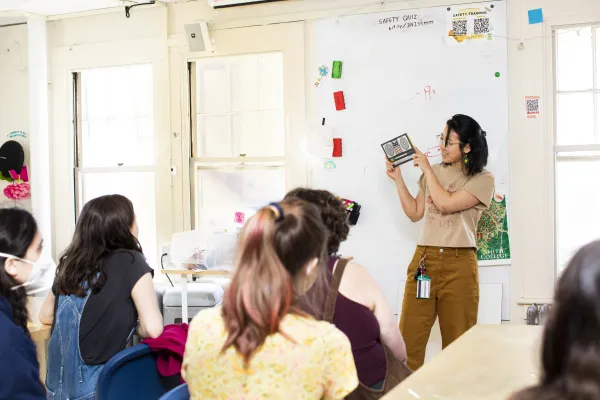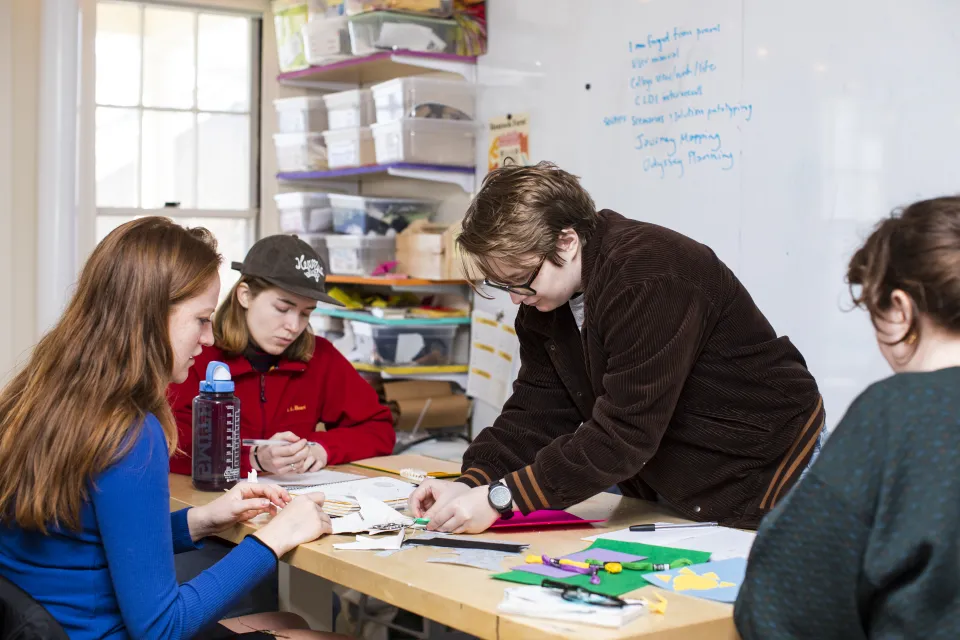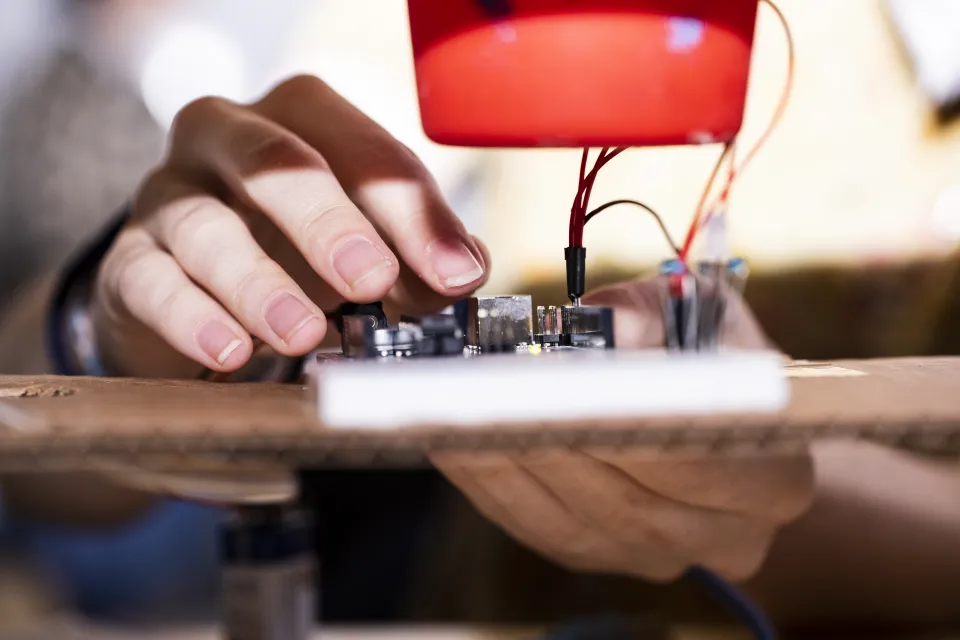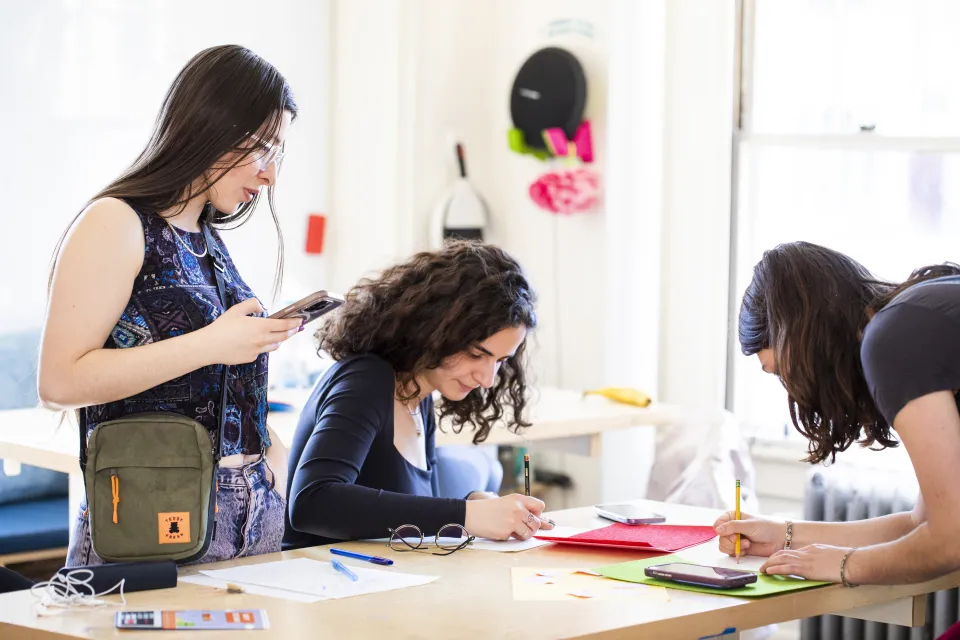The Joy of Making
Research & Inquiry
Pilot class offers a preview of a new academic concentration
Pilot class offers a preview of new academic concentration.
Photograph by Lynne Graves
Published September 26, 2023
At one table, an architecture major was creating a felt bear with a light-up heart. At another, two computer science majors (one doubling in data science and the other in math) were sketching figures with LED eyes and trying to use conductive cloth to create the “general vibe” of an emoji hug.
As the students worked, early-spring sunlight flooded their classroom at the Design Thinking Initiative, a small brown-and-yellow building on Henshaw Avenue where rooms are filled with boxes of crafting materials, and tools for turning them into projects line every shelf.
“It doesn’t have to come out right, or even come out,” explained Adriana Beltran Andrade ’23 as she glued wings on a felt bird. “This class is just about creativity and thinking outside of the box.”
Meet IDP 111: Introduction to Interdisciplinary Making, a new kind of class with a completely unique format. Part pilot and part gateway, the course set the stage for a maker concentration that was approved by the faculty in January and will debut this fall.
Concentrations, which can be added to existing majors, give students ways to focus on specific, and often practical, interests. As a poetry concentrator once described it, a concentration is “practical experience upon practical experience” with a tight-knit group of fellow students and “really passionate faculty and staff helping to guide us.”
Photograph by Lynne Graves
For Introduction to Interdisciplinary Making, hands-on exploration was the goal, and joy was a theme. The students who enrolled seem to have taken both ideas fully to heart. Where else could you learn to design your own wooden ruler, or spend the morning flying a kite—and get credit for doing so?
“I forgot how relaxing it could be to do an art project and just make things,” said Elaine Demetrion ’25, a computer science and mathematical sciences double major. “It’s a whole different part of your brain.”
As a preview of the concentration to come, IDP 111 was divided into two parts: a Monday workshop where students sewed, cut, built, and glued a variety of materials; and a Wednesday discussion where they pondered questions of scarcity, the nature of use, the life cycles of objects, and what kinds of making (and makers) have been historically valued and why.
When it came to what the students actually created, they were encouraged to stretch their imaginations. After all, the class was a pilot project in more ways than one: It is the first Smith offering designed as a “workshop series” instead of a lecture or lab series. It’s also the first to focus on introducing students to maker spaces—such as Hillyer’s wood shop, Mendenhall’s costume shop, and the Center for Design Fabrication—all around campus.
Photograph by Lynne Graves
“There’s a lot of support and interest to tangible making being a legitimate academic [area],” said Reid Bertone-Johnson, a lecturer in landscape studies who worked with Emily Norton, director of Smith’s Design Thinking Initiative, to brainstorm both the class and the concentration. “It’s the perfect bridge between arts and STEM”—science, technology, engineering, and math.
When former president Kathleen McCartney invited faculty to propose new concentrations two years ago, Norton and Bertone- Johnson answered the call with a plan to transform the existing maker spaces on campus into a more formal academic pursuit. As a bridge between disciplines, the maker concentration could eventually serve as a gold star on a résumé for students who want to break into high-profile companies or sectors.
“It’s the opportunity for the rubber to meet the road,” Norton said, “where students get to test themselves against material constraints and forces that don’t always behave in the same way as a diagram or computer model. That brings in this whole other way of knowing."
In class, students spent the spring making gliders, which they flew across the Indoor Track and Tennis Facility, and kites, which they sailed above Chapin lawn. They studied upcycling and sustainability by collecting trash from various maker spaces; they explored the spaces people occupy by creating sets for the theatre department.
Photograph by Lynne Graves
For a lesson in “rendering” (in all senses of the word), students designed their own candy molds, 3D-printed them, and, with the help of others on campus, collected maple sap to boil into syrup for sugary treats. That class was, in a word, delicious. “We ate a lot of candy,” Bertone-Johnson said.
For him, all of this is part of an overarching teaching philosophy. “I like to teach classes where students can’t believe they get credit for doing this stuff,” he said. “That’s my goal.”
The class is “one of the highlights of my week,” said Lesly Oquendo ’23 as she cut felt to create a bear. “It made me want to step out of my comfort zone in regard to other projects.
“I’m very jealous of the new Smithies-to-come who have this as a concentration,” she added. “I would have flourished.”



